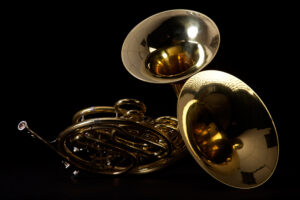26. September 2012
The characteristics of doublebell instruments
LTR: Bruce Collings, Christine Chapman, Melvyn Poore and Marco Blaauw
Ensemble musikFabrik is the only ensemble that owns a complete set of doublebell brass instruments. Marco Blaauw (trumpet), Christine Chapman (horn), Bruce Collings (trombone) and Melvyn Poore (tuba) illuminate the characteristics of these exceptional instruments in the following interview:
How did the conception of doublebell instruments come about? Who had the idea?
Bruce Collings: The doublebell was initially Marco’s idea and he has been trying to talk us into having doublebell instruments made for some time. With the exception of the plunger and in part the wawa mute, or harmon as it is sometimes called, it has never been possible to create really fast color changes. Through the desire to play these techniques the idea came of having a second bell.
Marco Blaauw: In my career as a soloist and ensemble player mainly performing contemporary music, I felt a strong need to enhance my trumpet. Somehow the trumpet
didn’t seem complete: new repertoire often uses quarter-tones and fast mute changes. Gradually I developed the idea of a trumpet that could do both easily: a quarter-tone, doublebell trumpet.
What tonal possibilities open up with a doublebell instrument?
Bruce Collings: Two separate bells allow fast changes between Almost any kind of mute and the open horn, or between two different mutes, with even a relatively seamless mixing and crossover of the two sounds.
Marco Blaauw: The 4th valve is for playing quarter-tones. In Combination with alternative fingerings on the other three valves, you can play even smaller microtonal steps. The 4th valve can also be used in a half-valve (hv) position. It makes the sound unstable, rather jazzy, fragile and soft, like a heavily muted trumpet.
Christine Chapman: One option that stands out on the horn from the other doublebell instruments’ color palette, is the “direct” horn sound when the second bell is swung towards the audience. Muted or open, the contrast between the traditional indirect sound and the sudden shift to a more brilliant, cutting color is wonderful.
Melvyn Poore: It is great to have the possibility of using a larger number of different mutes: the tubist normally works with one mute and that’s it. Now I can use a range of mutes in the second bell which is a bass trombone bell.
Are doublebell instruments widely spread and popular? What role has the Ensemble musikFabrik in this case?
Bruce Collings: In the beginning to the middle of the 20th century there were some doublebell instruments made. So far as I know, my doublebell trombone is the only one in the world which has the full range of the trombone on both bells. I could even stick another bell in the F valve and have three bells, although with certain range limitations.
Marco Blaauw: Many composers were inspired by the new possibilities. New repertoire has been written for my instrument: solo works, chamber music, works using electronics, and solos with ensemble and orchestra! Peter Eötvös was the first composer interested, even before the instrument was actually built. Christine Chapman: No, doublebelled brass instruments are not widely used and popular – yet! Marco has been running around with his trumpet for years now, so obviously everybody loves and wants the trumpet, but I’ve only had my horn since last fall, Melvyn’s euphonium is just a few months old and Bruce got his trombone in the mail maybe 3 1/2 weeks ago!

